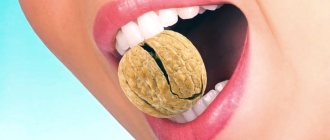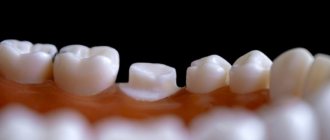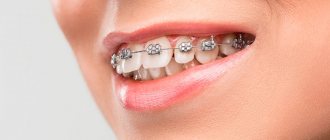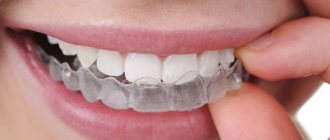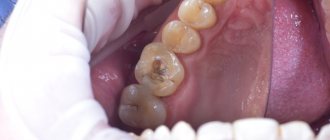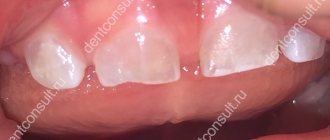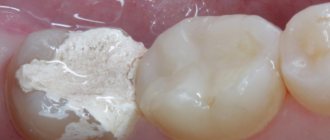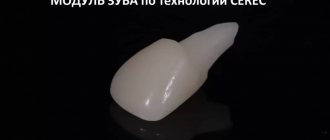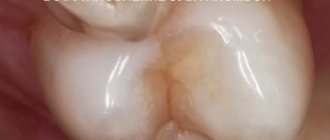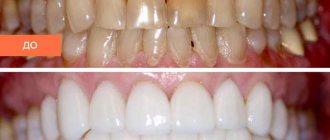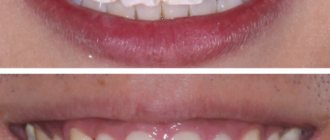Fracture of the front teeth occurs quite often in the practice of a dentist. This defect can be mild and affect only a small area of enamel, but sometimes the front tooth breaks at the root. What to do in such situations? Of course, go to the dentist. Today there are many methods that allow you to correct the problem, taking into account the individuality of each case.
The crown part of the front tooth is broken
If a front tooth is partially fractured, veneers or crowns can be used.
Veneers restore tooth function, protect dentin from external influences, and also the aesthetics of a smile. Treatment is only suitable for slightly damaged teeth. If the dental crown is severely damaged, the dentist will suggest installing a ceramic crown.
Crowns are placed on the remaining part of the tooth after grinding and preparing the surrounding area around the damaged tooth. If a significant part of the tooth has broken off, then to securely fix the crown it will be necessary to make a stump inlay, and in this case the tooth will have to be depulped (remove the nerve and fill the root canal).
The main stages of tooth restoration using a crown:
- Drawing up and agreeing on a treatment plan;
- Next, the doctor grinds the tooth down for a crown;
- Taking a silicone impression. The impression is sent to the dental laboratory. Based on the impression, the technicians reconstruct a plaster model of the teeth, and the technician will model the crown on it;
- When the crown is made, it is tried on and, if there is no discomfort, fixed on the stump.
To close the aesthetic defect, until the permanent crown is made, I install temporary plastic crowns on the patient, which can be made either in the laboratory or in the clinic.
Material for making dental crowns . Front teeth are a person’s calling card. When smiling, in conversation, every person involuntarily exposes his front teeth. Their beauty and health attract their interlocutor. This is why choosing the type of crown for teeth in the smile area is so important. The main types of permanent dental crowns are metal-ceramics, metal-free ceramics and ceramics with a zirconium dioxide frame. The most preferable material, from an aesthetic point of view, for the manufacture of dental crowns for the front teeth is metal-free ceramics e.max or feldspathic ceramics, also ceramics with a zirconium dioxide frame.
Peculiarities
Doctors distinguish three stages of tooth decay: minor, partial and complete. Based on the amount of remaining living tissue, the dentist chooses the method and material for restoration. In some cases, it is enough to fill a small chip with a composite or partially build it up with appropriate materials to give it a natural color and shape. If the tooth is completely destroyed, the question of making a prosthesis arises. In this case, therapeutic treatment is pointless, and a prosthetist dentist is involved in the process.
Restoration method – bridge prosthesis
Dental bridges got their name for their visual resemblance to a bridge - they are a structure of two crowns, between which artificial teeth are located.
Crowns are placed on your own ground teeth. The advantages of bridges are good aesthetics and reliable fixation. Dental bridges are permanent, making them very comfortable. This type of dental prosthetics requires several visits to the doctor. First, impressions are made, from which a temporary prosthesis is made in a denture laboratory or clinic - the patient will not experience discomfort when communicating due to the absence of a front tooth. At the same time, the dental clinic prepares the supporting teeth. They are ground to install a crown to a shape that is optimally suitable for this, and most often (but not always) they are depulped. After the grinding is completed, impressions are taken again, from which dentists make a permanent prosthesis, and after that it is installed on the supporting teeth and fixed with cement.
The main disadvantage of a bridge is the need for depulpation and grinding of healthy supporting teeth. In addition, its installation, which leads to an uneven load on the alveolar bone and its thinning in the area of the missing tooth..
What to do if a tooth is broken
It is clear that if a tooth is broken at the root, the patient will immediately consult a doctor, but one should not think that small chips and cracks can wait. The sharp edge scratches the tongue and cheek from the inside and can cause traumatic stomatitis. Cracks in the enamel deepen and lead to tooth hypersensitivity. A chip of any tooth affects the distribution of the chewing load. For intact teeth, it increases significantly, and this threatens additional injuries, now to these units.
Violation of the integrity of the tooth opens the way to internal tissues for pathogenic bacteria. Minor trauma can result in caries, pulpitis (inflammation of the pulp), periodontitis (inflammation of the tissue around the root), and ultimately, tooth loss. Therefore, a visit to the dentist is the first thing you need to do.
Restoration method - one-stage implantation immediately after root removal
Single-stage implantation of a front tooth involves immediately installing an implant into the socket after tooth extraction. For this type of implantation, special dental implants with aggressive threading and a high degree of primary stabilization are used. On the same day, immediately after implantation, a temporary plastic crown is installed. This implantation allows you to solve two problems - removing a broken tooth root and closing a cosmetic defect. In addition, the method allows you to save a little, because... Some manipulations are not performed (for example, the gum former is not installed).
After 3-4 months, when osseointegration of the implant is complete, permanent crowns are installed. Just as in the case of conventional crowns, from an aesthetic point of view, the best solution for the front teeth is the use of ceramic crowns and, accordingly, abutments. It is preferable to install the crown on a zirconium dioxide abutment, then in any type of lighting the crown will not stand out from the general row of teeth. In our opinion, this option for restoring a broken front tooth is the most optimal.
Direct and indirect method
Depending on the degree of destruction, when restoring the front teeth, as well as all the others, two methods are possible: direct and indirect. In direct cases, minor defects are eliminated using modern high-quality composite materials, which help bring the color and transparency of the crown as close as possible to natural values. The indirect method allows the use of onlays and veneers for restoration. For a professional dentist, extension is a simple procedure, regardless of its location in the jaw. Although, for example, restoration of a broken wisdom tooth is extremely rare due to difficult access. Most often, damaged wisdom teeth are simply removed, since they are a vestige and do not carry any functional load.
How to repair a broken tooth
There are two main types of tooth augmentation (restoration).
- Direct extension. The doctor performs reconstruction directly in the oral cavity using composite materials, which he applies layer by layer. After treatment with ultraviolet radiation, the material hardens and becomes very durable.
- Indirect extension. During restoration, materials are used that are manufactured on high-precision equipment in a laboratory. These include crowns made of ceramics, metal-ceramics, zirconium, as well as microprostheses - veneers, inlays. Manufacturing and installation may take up to 14 days.
The choice of material and price depend on how large a piece of tooth needs to be built up. If a small part has broken off, restoration with composites is used; if more than 50% of the tooth surface is destroyed, it can only be restored with an inlay or a crown.
Make an appointment
Dental care in Moscow
In order to efficiently and inexpensively restore a broken or chipped tooth, contact our clinic.
We use:
- innovative treatment methods that allow you to achieve ideal results in the shortest possible time;
- durable, biocompatible materials, thanks to which the restored teeth do not differ from natural ones in structure, color, and light refractive index;
- advanced computer technologies that help create high-precision restorations and prostheses.
You can find out how much dental treatment will cost at a free consultation with a specialist. Sign up now!
THE RECEPTION IS HOSTED BY:
MNATSAKANYAN LAURA GRIGORIEVNAComprehensive professional cleaning of the oral cavity, treatment of caries and its complications, professional teeth whitening, aesthetic restoration of teeth, microprosthetics (veneers, onlays), dental prosthetics, implant prosthetics |
| What to do if you break a tooth? Is it possible to restore a broken molar or chipped front tooth? At the Cervantes clinic, where advanced technologies and modern materials are used to restore teeth, you can! | What to do if you break a tooth? Is it possible to restore a broken molar or chipped front tooth? At the Cervantes clinic, where advanced technologies and modern materials are used to restore teeth, you can! |
Prevention of tooth fracture
Athletes and stunt performers can only be given one piece of advice - use a mouthguard, this will reduce the risk of injury.
Mouth guards are the key to health
General recommendations for maintaining strong and healthy teeth:
- take good care of your teeth, gums, and tongue;
- use high-quality certified toothpaste or gel with therapeutic and prophylactic additives to strengthen the dentition;
- take vitamin complexes for gums and teeth with dietary supplements and useful minerals;
- Eat a healthy, balanced diet. There should be a sufficient amount of fresh vegetables, fruits, cottage cheese, fish, and hard cheese on your table - this will help maintain the health of the soft and hard tissues of your teeth. Try to eat less flour, sweets, too hot and cold, salty, as well as foods containing preservatives, dyes and other “chemicals”;
Products good for teeth
- Maintain a balance of solid and liquid foods. Both excess and lack of chewing load are equally harmful to teeth;
- Seek medical help in a timely manner for infectious and chronic diseases, monitor the normal functioning of the gastrointestinal tract and metabolism. The consequences of malfunctions in the functions of internal organs cannot be eliminated with the help of expensive paste or repeated hygiene procedures;
- take vitamin complexes for gums and teeth with dietary supplements and useful minerals;
Vitamins for teeth and gums
- try to give up cigarettes, excessive drinking and other bad habits;
- If you have any problems with your teeth or gum tissue, consult your doctor. Fragility of dentin and inflammation of the roots are the causes of tooth decay;
- make it a rule to visit the dentist once every six months for a routine examination, even if nothing bothers you.
Visit the dentist every six months
Don't forget about the financial side of the issue. Dental augmentation is far from a cheap procedure, and the cost of implants is even higher. Preventing a problem is always easier than eliminating its consequences.
Relationship between types of fracture and treatment
The specifics of treatment largely depend on the type of fracture you have. So:
- Vertical or longitudinal. The fracture line is directed parallel to the longitudinal axis of the tooth. In this case, it will not be possible to install the pin. It is also difficult to carry out pinpoint diagnostics. Therefore, in most cases, such a tooth must be removed. But keep in mind that the dentist must make the conclusion.
- Transverse fracture. In this case, the fracture line runs parallel to the chewing surface of the tooth. Treatment depends on how much of the tooth is preserved. If the molar was initially healthy, that is, this is not a fracture situation due to a carious cavity, then in 90% of cases with such a fracture, the tooth is restored. The damaged crown is usually augmented. The dentin and sometimes the pulp may also be removed. Recovery occurs at the base of the pin.
- Oblique fracture. In this case, the line goes diagonally. It is difficult to assess the likelihood of recovery in advance; you need to take pictures of the tooth and look at its general condition.
- Splintered. In this case there are several fracture lines. As a rule, the tooth is removed because it is quite damaged; the attempt to restore it will not give a good result. However, the final conclusion is made by the doctor.
If a person has several damaged teeth, the types of fractures can be different. In any case, you must first undergo a diagnosis.
Diagnostics
No self-respecting dentist will make any promises before conducting a diagnosis. If a tooth is fractured, you need to take an x-ray and possibly a computer examination. In any case, what is needed is not a point-by-point examination, but at least one panoramic image. This is necessary to make sure that everything is in order with the rest of the teeth. At the same time, other pathologies will be noticeable.
Diagnostics helps to get answers to the following questions:
- Is the root intact? What condition is the root system in? If the root is damaged, there is often little point in trying to save the tooth. However, it all also depends on the type of tooth. If it is chewable, for example, we are talking about 6, then in this case restoration is possible, even when part of the root is affected.
- Are the root systems of other teeth affected? Sometimes, as a result of an injury, a person may be in so much pain that he may not notice that several molars are damaged.
- How many teeth are fractured? As mentioned above, the patient does not always understand how serious his injury is.
- Is the tooth displaced? The dentist needs to understand whether he should return the tooth to its proper place (or remove it, which in case of severe displacement will be the best option).
- In what direction did the fracture occur? This is important to determine for the reasons stated above. It is not always possible to establish this externally. Please note that the fracture line may visually resemble a crack. Therefore, nothing can replace an x-ray.
- Are the surrounding tissues changed? The doctor needs to see the whole picture as a whole.
- Are there hidden foci of inflammation? This is also very important for full recovery and choosing the correct therapy program.
Direct diagnosis is carried out using x-rays. However, other options are possible, for example, computer examination.
Price for extension per pin
Even when the crown part of the tooth is completely destroyed, it is possible not to remove the remaining root, but to build the tooth onto a metal pin installed in the root canal. For extension, composite materials are used, which are applied layer by layer to the pin, forming a new tooth.
The advantages of the method are the ability to preserve the root and restore the tooth if it is completely destroyed. The cost of the procedure at Doctor Bon dentistry is from 7,000 rubles.
| Tooth restoration with filling materials using anchor pins or fiberglass | 7,000 rub. |
Types of destruction
A chip is a damage to the enamel or dentin that occurs as a result of mechanical stress and leads to a violation of the integrity of the dental crown. With such destruction, the roots are not affected, and the tooth remains in its place.
Most often, part of the crown breaks off as a result of an injury caused by a fall or a strong blow.
However, there are other reasons why such damage occurs:
| deep caries |
| fragility of hard tissues resulting from depulpation |
| malocclusion |
| weakening of enamel due to lack of calcium in the body |
| violation of the rules of operation of orthopedic and orthodontic structures |
| poorly made filling (as a rule, molars are damaged because of this) |
| bad habits |
Under strong mechanical stress, the tooth may not just chip off, but break. A fracture is an injury that leads to a change in the anatomical shape of the tooth, destruction of bone tissue, and often to injury to dentin and pulp.
Repairing chips on artificial teeth
Unfortunately, no one is immune from injury, so there is a possibility of damage to artificial teeth, for example, temporary metal-plastic crowns, ceramic products (in cases of high load on them) or metal-ceramic crowns. In such cases, the product can be polished, removed with subsequent repairs, or an artificial crown can be built up directly in the oral cavity using special materials - silane, opaque composition and a halogen lamp.
Polishing artificial teeth
